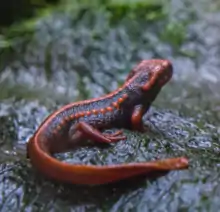Tylototriton shanjing
Tylototriton shanjing, the emperor newt, Mandarin newt or Mandarin salamander, is a highly toxic newt native to China.
| Tylototriton shanjing | |
|---|---|
 | |
| Scientific classification | |
| Domain: | Eukaryota |
| Kingdom: | Animalia |
| Phylum: | Chordata |
| Class: | Amphibia |
| Order: | Urodela |
| Family: | Salamandridae |
| Genus: | Tylototriton |
| Species: | T. shanjing |
| Binomial name | |
| Tylototriton shanjing Nussbaum, Brodie & Yang, 1995 | |
Description
Tylototriton shanjing can grow up to 8 inches (20 cm) long. It has a ridged orange head from which a single orange ridge runs along its back. This ridge is lined with two parallel rows of orange bumps on a black background. The tail and legs are entirely orange. The shade of the orange can be variable.[2]
Defense
Tylototriton shanjing might seem like easy prey because of its bright coloration, however, it is generally nocturnal, and the top of its vertebrae and skull have especially thick bone.[2] Additionally, the orange warts on its back are poison glands, and when the newt is grabbed, the tips of the ribs will squeeze out poison from the glands. Emperor newts have enough toxin to kill approximately 7,500 mice.[3][4] Although poisonous, these newts are generally safe for human handling provided that they are handled carefully and gently.
Range and habitat
Emperor newts live in central, western, and southern Yunnan, China, between 1000 and 2500 metres above sea level.[5]
They inhabit pools and slow-moving streams in subtropical forests.[6]
Diet
The emperor newt usually eats small invertebrates in its environment, such as crickets and worms. Emperor newts in captivity are typically given wax worms, crickets, and earth worms.
Taxonomy
For a long time, emperor newts were classified together with the Himalayan newt (T. verrucosus).
References
- IUCN SSC Amphibian Specialist Group (2020). "Tylototriton shanjing". IUCN Red List of Threatened Species. 2020: e.T59485A63871498. doi:10.2305/IUCN.UK.2020-2.RLTS.T59485A63871498.en. Retrieved 20 November 2021.
- torontozoo.com ("Toronto Zoo > Meet the Animals > Fact Sheet". Archived from the original on 2006-11-11. Retrieved 2006-09-18.); accessed 9/18/06
- detroitzoo.com (http://www.detroitzoo.org/Attractions/Amphibiville/Animals); accessed 9/18/06
- Caudata.org (http://www.caudata.org/cc/articles/toxin2.shtml) Accessed 1/10/07
- livingunderworld.com (http://www.livingunderworld.org/caudata/database/salamandridae/tylototriton/shanjiing); Accessed 11/4/06
- tylototriton.org ("Archived copy". Archived from the original on 2007-09-28. Retrieved 2007-07-02.
{{cite web}}: CS1 maint: archived copy as title (link)); Accessed 2/7/07


.jpg.webp)